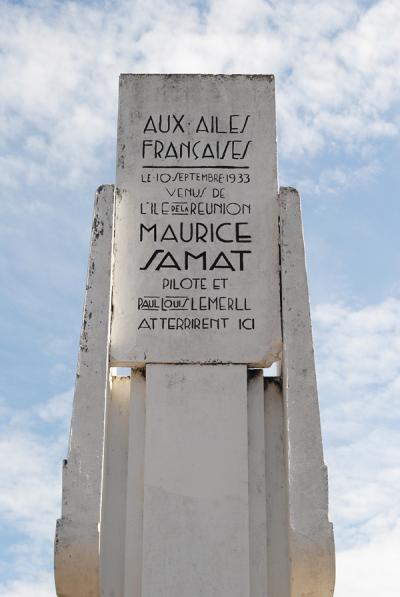In describing the paradisiac beauty of Mauritius, the panorama will remain incomplete if no mention is made of Mon Choisy. Undoubtedly, it is the favourite beach of many Mauritians and the dream resort for tourists. With its bay of turquoise water gently washing the balmy white sand, the beach has a unique atmosphere, enhanced by the whispering of the filaos (also known as casuarinas).
The filao trees have been a recent introduction in the flora of Mauritius. In fact, it was the French explorer and cartographer Abbé Alexis Rochon who brought the first seedlings of filao on the island in 1778. But the credit goes to the British for having multiplied them all over the island. The Franco-Egyptian successful experiment in planting filao trees along the Suez Canal to arrest the drift of sand into the canal had made a lot of echo. The British quickly realized that the filaos were salt-tolerant, quick-growing and did not require much rain. The British Governor, Sir Arthur Gordon (1870-74) ordered that the filaos, which resembled slender conifers, be planted around the coastline of Mauritius as part of the tree and water conservation system and a protective belt against beach erosion and sea gusts. The filaos at Mon Choisy, with their feathery dark green branchlets, give a Mediterranean touch to this beach resort.
Evidently, Mon Choisy has more in its store that its whispering filaos can witness. It is not only an enchanting place for beach leisure and natural “therapy” for de-stressing, but a popular arena for socialization and harmonious intermingling of the diverse cultures of Mauritius.
Very few people realize that Mon Choisy had once been closely associated with the socio-economic history of Mauritius. At the northern end of Mon Choisy which adjoins the boundary of Pointe aux Canonniers, the British colonial authority had built a quarantine station to treat patients caught with epidemic diseases. This onshore station was an addition to the offshore quarantine on Ile Plate. In the mid 19th century, the need for properly equipped quarantine stations was strongly felt with the increasing advent of Indian indentured labourers who were highly vulnerable to epidemic diseases. In 1856, the neglect of proper sanitary precautions at a quarantine station was a cause of frightful mortality among the indentured labourers. The situation was so alarming that the Indian Government had to put a temporary ban on the export of indentured labourers. The Commercial Gazette of 6 January 1857 reported that the Legislative Council of the Mauritius met on 5th January 1857 behind closed doors to discuss the issue of Indian Government stopping immigration and decided that Flat Island should be retained as a quarantine station, but then when Flat island would be inaccessible due to rough sea conditions, the quarantine station of Pointe aux Cannoniers should be made available for cholera patients. However, the British finally opted to retain the ailing passengers in Bell Buoy – much to the latters’ discomfort as they were totally exhausted after almost 40 days of tiresome sea-voyage from Calcutta. The story of the quarantine station at Pointe aux Canonniers became pathetic when, in the late 1880s, thousands of Mauritians died from epidemic diseases. The situation became more serious when many doctors hesitated or refused to go on frontline to cure the patients. Nonetheless, a young doctor of hardly 30 years, Dr. Idrice Goomany, ventured to take the challenge and he took charge of the quarantine station in 1889. It did not take him long to catch the virus of smallpox and died on 20 July 1889 in honourably exercising his professional duty. He was buried in the compound of Pointe aux Canonniers quarantine station (now transformed into Club Med) with an epitaph reminding that he died while saving the life of others.
At the southern edge of the Mon Choisy’s football lawn stand, the “Monument Samat”, commemorating the landing of first aeroplane from abroad. An earlier attempt by Major F.W. Honnet to fly over Mauritius by taking off from the Gymkhana on 2 June 1922 could be considered as an one-off inland trial because the plane was carried to, and out of the island by ship. But the first effective international flight to Mauritius took place a decade later. On 10 September 1933, Maurice Samat and Paul Louis Lemerle made the first flight from Reunion to Mauritius in a Portez 42 and landed on a racecourse at Mon Choisy which was converted into a airstrip. Thus, for some years that followed, the Mon Choisy airstrip was used as an airport for the rare aeroplanes that landed on the island. However, during World War II, Mauritius gained a strategic importance in the Indian Ocean. In 1942, the British Government hastily built a new airport at Plaisance in the south of the island. Since then the airstrip at Mon Choisy has been buried in sand and perhaps, would have been erased from our memory had there not existed the “Monument Samat”.
At hindsight, the transfer of the airfield from Mon Choisy to Plaisance has been a blessing in disguise for beach lovers. Had the airport been maintained at Mon Choisy, it would have evidently expanded and encompassed the neighbouring villages of Trou aux Biches, Pointe aux Canonniers and part of Triolet. Mon Choisy would have become a restricted area with its beach inaccessible and the whispers of its filao trees silenced forever.
SOCIO-ECONOMIC HISTORY OF MAURITIUS: Mon Choisy where the filaos whisper
- Publicité -
EN CONTINU ↻


